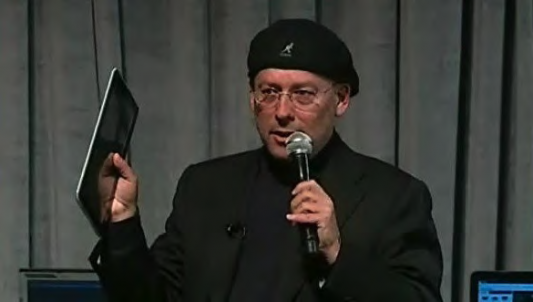A slightly skeptical view of the competitive landscape.
By Jon Peddie

The red lady has bowed out, and this year’s IFA show has ended in Berlin, but we saw a slew of new tablets from HP, Lenovo, Samsung, Asus, Acer, Sony, Toshiba, Dell, Archos, and others—all with amazing specifications, app stores, and processes. We’ll be seeing them come to market throughout the year.
Amazing proliferation, and all vying for the little bit of the market Apple doesn’t get or want— the trough is over there, fellows, enjoy the scraps. After IFA, that clever Jeff Bezos threw his own show and introduced the only tablets that really scare Apple—the Kindle Fire line.
All us crystal ball gazers, tea leaf readers, and bone tossers know with total certainty the tablet market will reach 50 million in 2014 or 100 million in 2015 or maybe it’s 200 million in 2016. We know this, we’ve got this, this is what we do, we call it, predict it, so watch this space for the latest forecast.
It’s actually not as hard as it looks (or we make it sound); you simply take Apple’s shipment numbers, which they are happy to provide, and multiple by a factor of … 1.3, 1.4, whatever feels good, or makes your client feel good. (In Q2, Apple sold 17 million tablets for a 70% ± 15% share of the market.)

The hard part is getting the laggards to fess up on their shipments. Those requests are usually met with, “We don’t share that data,” or no answer at all. It’s a dead giveaway they are embarrassed, as well they should be, being late to market with me-too products hoping to cash in on Apple’s trail-blazing regeneration of the tablet market.
Apple provides one of the two major operating systems for tablets. Google’s Android is the second, and the third, Windows 8, is soon to come. Any person with a decent amount of common sense could easily predict that other tablet suppliers with a different operating system will steal some market share away from Apple.
And of course they will. As difficult as it may be to believe, not everyone loves Apple—no, really. And, Apple does have some supply channel issues. Retina displays are hard to build, and the yield rate isn’t that high, yet, which is why the competitors have to offer last year’s resolution and hope to make it up on price, er, or is that volume???

Then there’s the store. Amazon has the best shot at competing with the iStore (no, I did not say eye-sore). The rest? HP, Samsung, Lenovo, Asus, etc.? Not a chance. That’s why they’re all ceding that business to Google and its Play store. For one thing, none of the dwarfs, other than Amazon, has the stamina to be in the store business. It’s a long-term commitment that requires continuous investment.
For another thing, none of the dwarfs, again except Amazon, understands an online store; they have no history really. In addition, none of the dwarfs, including Amazon, has a backup with a retail chain. Microsoft has stuck their toe in the retail store business and will have a tablet, but Microsoft hasn’t demonstrated any staying power in any markets other than Windows and Office—does anyone know where I left my Zune?
So where does that leave the consumer? Well, if you don’t want to end up with an orphaned product, it leaves you no choice. I remember how excited we were about the Creative MP3 player, and the Logitech IPTV box, and the Microsoft game controller, and well, we get excited easily.

It’s a big hill in front of the other dozen tablet suppliers—the marketspeak catchword today is “headwind” (last year it was “wheelhouse”). So if it’s not in your wheelhouse, you’re probably going to encounter some headwinds, which means one simple, basic, annoyingly undeniable thing: you didn’t do your homework. You didn’t measure the market, you didn’t talk to the consumers, and if you did, you either led the witness or just heard what you wanted to hear.
And that all comes back to investment. Can the tablet makers make the investment needed—other than designing a me-too product and going into production—to be successful in the market? And secondarily, can they do it without stepping on someone’s IP?
Patents are public documents, but you do have to pay someone to read, and understand, them—oh, that investment thing again—damn.
Jon Peddie is President of Jon Peddie Research, the publisher of GraphicSpeak.
Related
Can Microsoft Surface win a me-too tablet war?
New Kindle tablets should strike a fire in Apple
Amazon walks a tablet tightrope
Nvidia’s big brand tablet sweep





